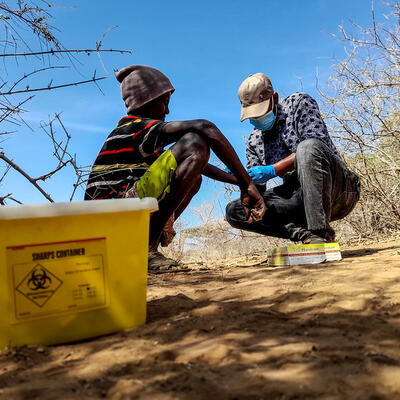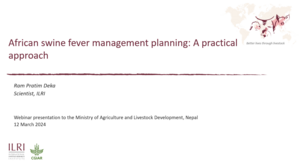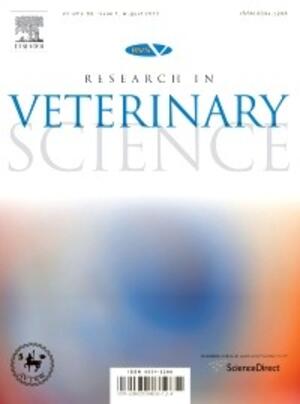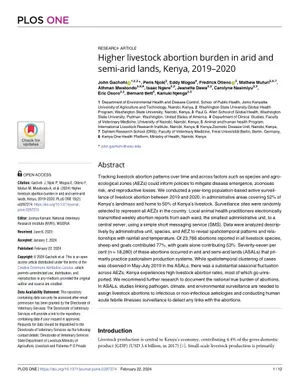
Climate-smart farming offers hope to Zimbabwe’s smallholders and livestock keepers
For 60-year-old Maxwell Machivenyika, farm-life was filled with tedium, drudgery and challenges. To get the job done working on his small farm meant waking up at 4 a.m. daily. Machivenyika has been growing maize, Zimbabwe’s main staple crop, since 1988. But his yields have been poor because of using inefficient farming methods.
A resident of Ward 7 of Mutoko District in Zimbabwe’s Mashonaland East Province, Machivenyika, like many smallholder farmers in rural districts in the country, does not get much produce or income from farming because most of the areas in Buhera and Mutoko have poor soils and experience low and erratic rainfall. Also, approximately 80% of the rural households are dependent on rainfed agriculture, making them highly vulnerable to climate change-induced weather extremes and variability. And, despite numerous advances in agricultural technology, crop harvests in these areas have been decreasing over time.
Smallholder farmers in rural areas also keep livestock to cope with climate shocks. The farmers sell their livestock during droughts to maintain the household. Cattle are also kept for draught power.
About 68% of Zimbabwe’s 15 million people (according to World Bank statistics of 2020) who live in rural areas depend on smallholder farming, whose stability is compromised by declining soil fertility, high costs of farm input and volatile profits from agriculture. The COVID-19 pandemic is also worsening this precarious situation even further because of movement restrictions on people and public transport, threatening agricultural input supplies to agrodealers.
But an ongoing livestock production systems project is seeking to help Machivenyika and other farmers increase food crop production for their households and fodder availability for their animals especially during the dry months of August to November.
The Livestock Production Systems in Zimbabwe (LIPS-Zim), a four-year (January 2020 to December 2023) EU-funded project focuses on increasing agricultural productivity in Zimbabwe’s agro-ecological regions IV and V. Its aim is to increase adoption of climate-relevant innovations in livestock-based production systems and improve surveillance and control of livestock diseases in these zones. The International Livestock Research Institute (ILRI) is partnering with International Maize and Wheat Improvement Center (CIMMYT), the French Agricultural Research Centre for International Development (Cirad) and the University of Zimbabwe, to implement the project on behalf of the Government of Zimbabwe.
Working in nine rural districts, LIPS-Zim is researching on technologies and models that can help to increase the adoption of business-oriented and climate-smart livestock feeding practices.
Before participating in the project, Machivenyika was used to the traditional way of farming that his family was accustomed to. Each October, they would clear the land and burn all remaining crop residues from the previous season to get a clean seedbed for their crops. But this practice causes depletion of the ozone layer through increased carbon emissions, deforestation and heavily depletes soil nutrients because the land is not given time to regenerate. It also destroys crop residues that could be used as livestock feed.
Machivenyika has stopped this practice. He says he has learnt the benefits of conservation agriculture, a crop management system based on minimum soil disturbance, crop residue retention mulching and crop rotations.
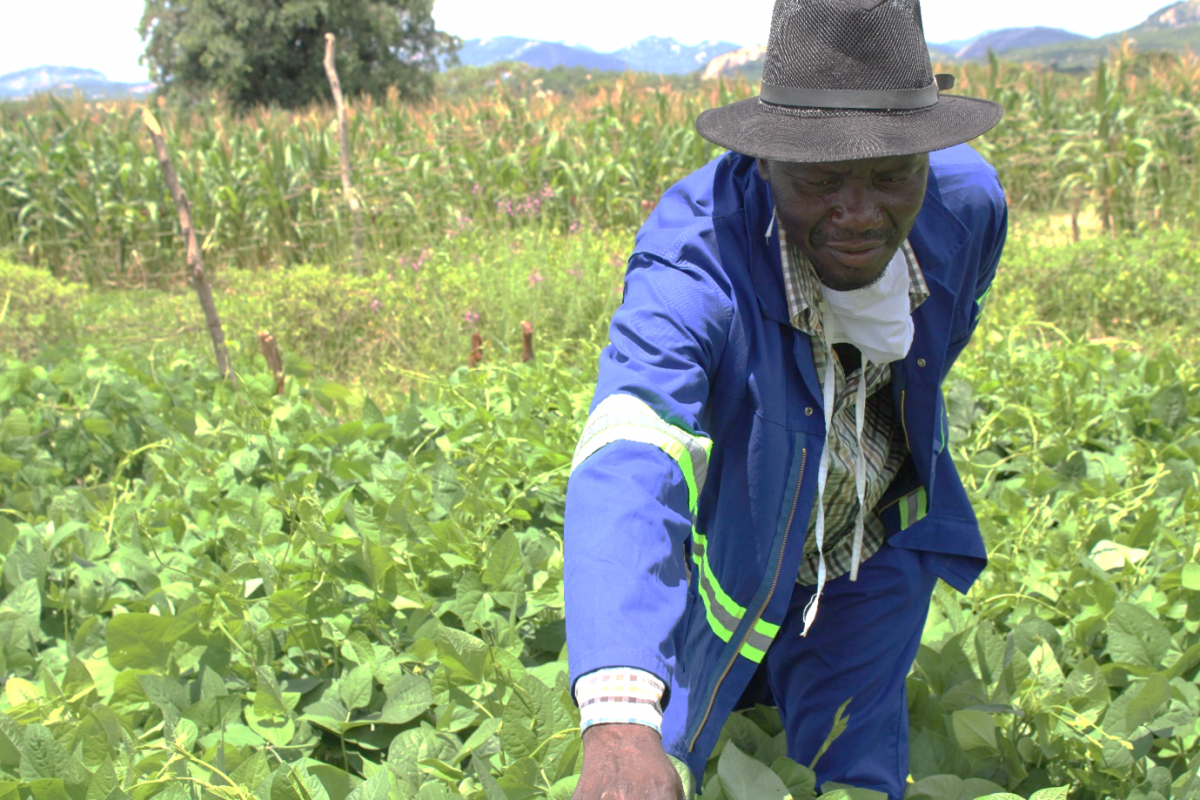
Maxwell Machivenyika says cowpea offers leaves for relish, groundcover to suppress weeds, and soil fertility improvement, grain at harvest and livestock feed (photo credit: Cirad/Johnson Siamachira).
‘Making use of the combined benefits of minimum soil disturbance, crop residue retention and crop rotation, conservation agriculture yields better when compared to conventional agriculture practices after two to five cropping seasons,’ said Isaiah Nyagumbo, a CIMMYT regional cropping systems agronomist while briefing farmers at a field tour in Ward 13 in Buhera District.
Participating farmers in Mutoko and Buhera districts showcased a wide-range of fodder and conservation agriculture-based technologies during a two-half-day field tours in February 2021. The Mutoko tour was held on 9 February while the Buhera tour was held on 17 February. The tours were organized to create awareness and field exposure to the project’s stakeholders about the climate smart feed production and water conservation initiatives being implemented by the project in all the districts. Representatives of LIPS-Zim project, government stakeholders, farmer organizations, and the University of Zimbabwe were visiting the farmers and took part in the events.
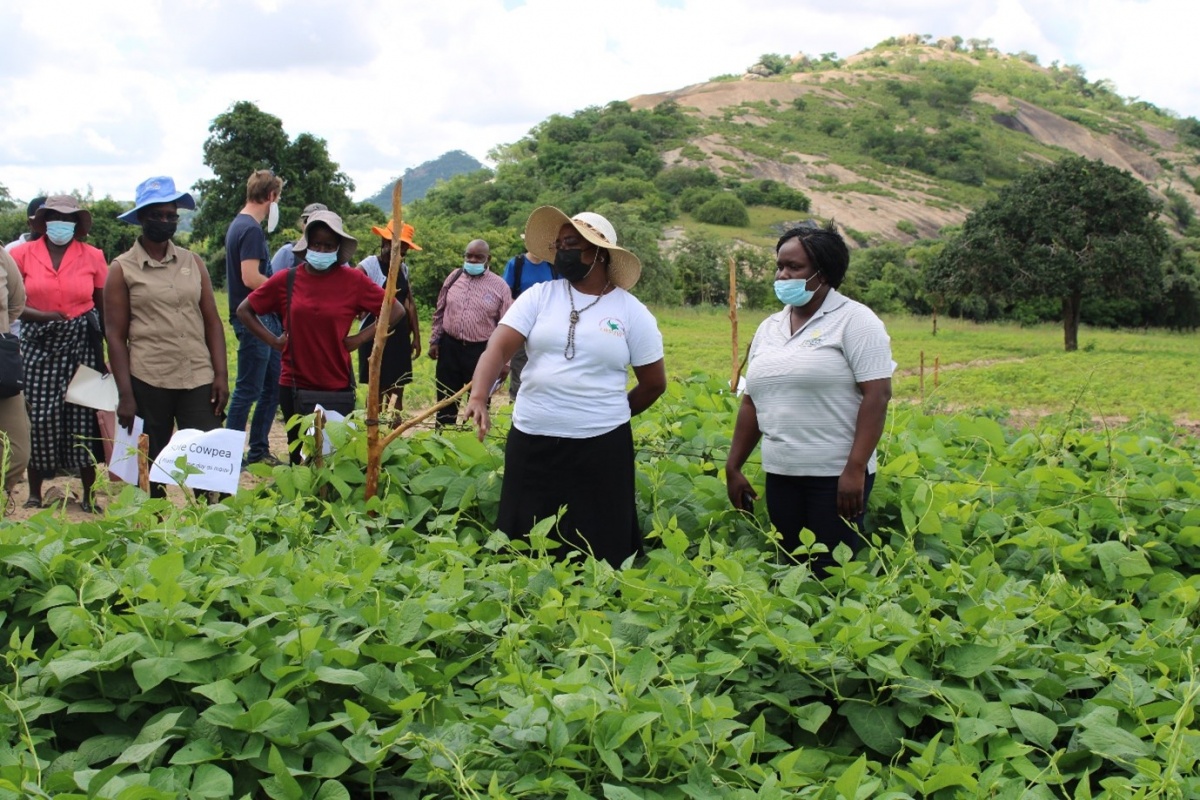
Project stakeholders at the Mutoko field tour. Irenie Chakoma, from ILRI, explaining feed harvesting to stakeholders (photo credit: Cirad/Johnson Siamachira).
Tongai Mahachi of Buhera district says the ‘project is helping community members work together to learn from each other and farm better.
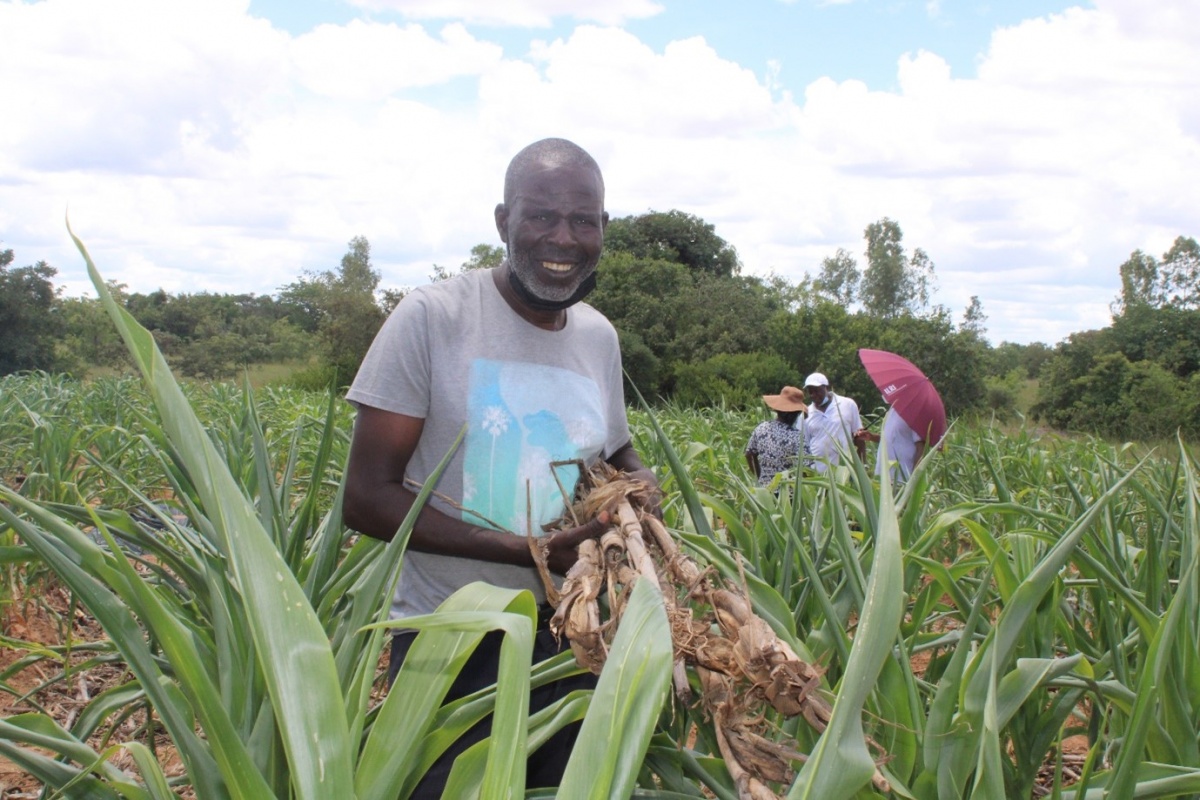
Tongai Mahachi showing visitors maize stalks that he uses for organic mulch (photo credit: Cirad/Johnson Siamachira).
‘We are no longer sure when to start preparing the land or when to start planting because the rains no longer come in time and are often insufficient. We’re pretty much gambling with nature,’ Mahachi says.
But during the visit, farmers showed how they are trialling techniques that help preserve moisture and increase soil fertility. This included the use of plastic and organic mulch and conservation agriculture basins and tied ridges without mulch or with either plastic or organic mulch.
Farmer Martin Gopo of Ward 7 in Buhera District is engaged in intercropping and growing drought-tolerant maize varieties, quality protein maize and pigeon pea.
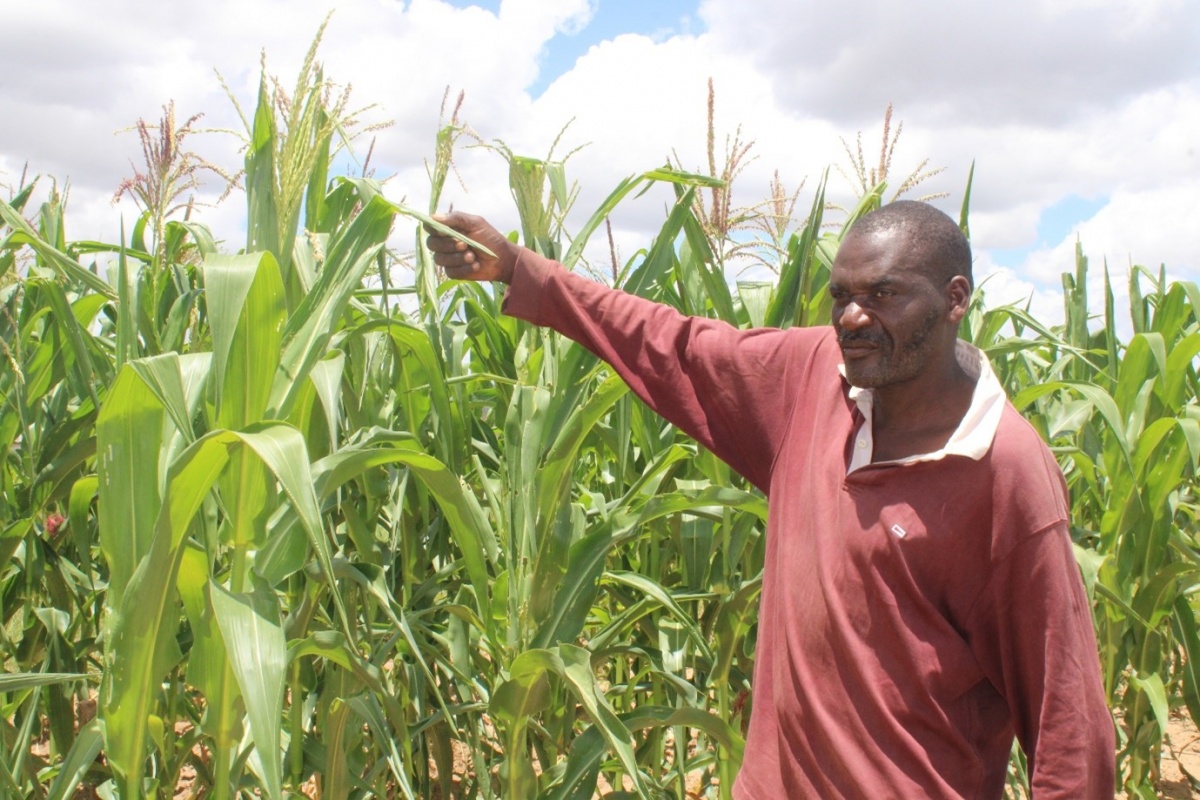
Martin Gopo has had first-hand experience with the intercropping trials that he says will enable him adopt the practice on his own farmer-managed plots. (photo credit: Cirad/Johnson Siamachira)
To improve on livestock feeding, the farmers in both Mutoko and Buhera have also been trialling fodder production technologies. Demonstration plots have been established in each of the three wards per district to enable farmers learn of available forage crops, fodder crop management, feed conservation and feeding methods. In addition, participating farmers have embarked on production of fodder of legumes (mucuna, lablab) and grasses (forage sorghum, Brachiaria and Napier grass).
Traditionally, lack of appropriate technologies such as fodder production hampered efforts to improve the quality and availability of fodder, which accounts for 70% of all livestock inputs in the country. LIPS-Zim has introduced an integrated crop and livestock management approach that will ensure consistent supply of high-quality feed by promoting home-based fodder production by farmers.
In their small demonstration plots, more than 100 farmers in the two districts are experimenting with mucuna, lablab and jack bean which they can use to supplement livestock feed. Using fodder as supplementary feed for livestock is ideal and affordable to produce. Farmers are also being encouraged to use available feed resources on their farms, such as groundnut stover to feed their animals.
LIPS-Zim is working with smallholder farmers such as Tobias Mapeto in Ward 7 in Buhera District, and other farmer to improve the dairy productivity of their animals, through feed interventions and training and technical assistance. The feed trials are using lablab, cowpea and velvet bean as forages. Growing forages provides year-round access to good-quality feeds during the dry season, and increases both the quantity and quality of animal feed while reducing feed costs.
‘Neighbouring farmers now recognize my contributions and I have earned a lot of respect from them as they come to me for advice on fodder production,’ said Mapeto.
In the next farming season, he wants to expand his forage farm from I hectare to 2 hectares. Buhera and Mutoko farmers will also be trained to produce hay and to make home-based feeds through animal feeding demonstrations.
The project team has identified scalable technologies in its project portfolio and encourages farmers to choose those that they can adopt in their farms using the mother-baby trial approach. The menu of practices includes fodder production, rotations, intercropping, herbicide use and improved drought-tolerant maize varieties.
The project is moving beyond trials to farmers’ fields and adoption and out- scaling beyond researcher-managed trials is expected to create a critical mass of ownership by the smallholder farmers who will in turn produce feed and improve livestock productivity.
Visit the LIPS-Zim website for more information: https://lips-zim.org/.










